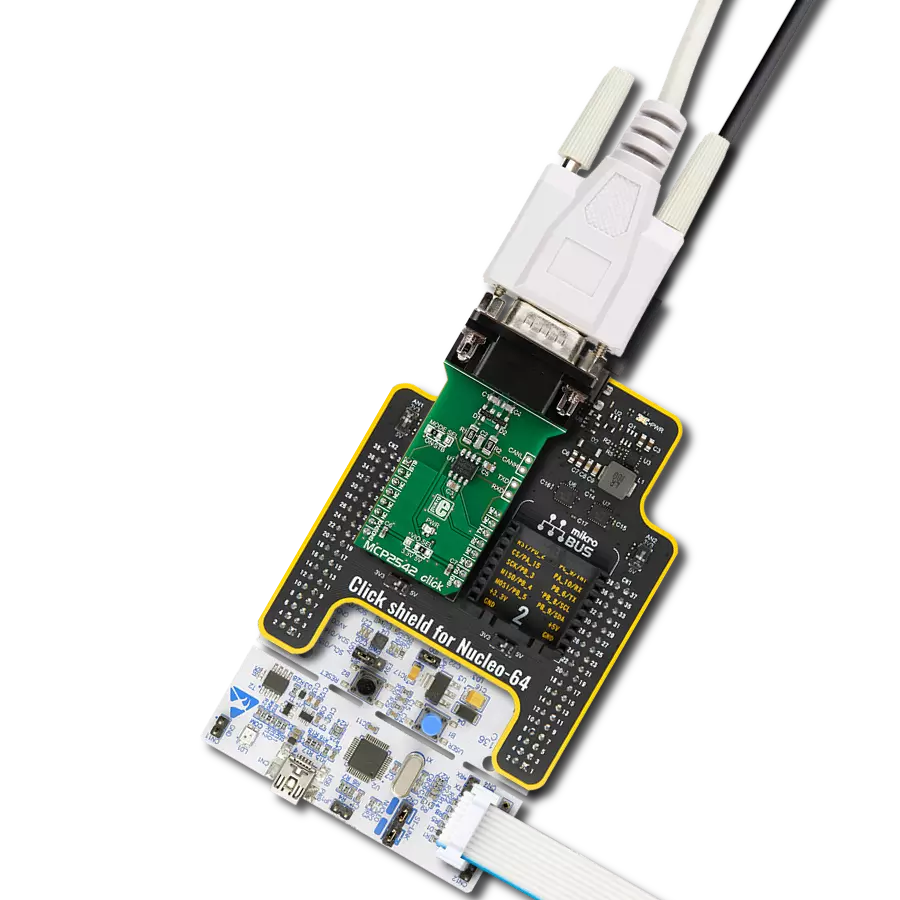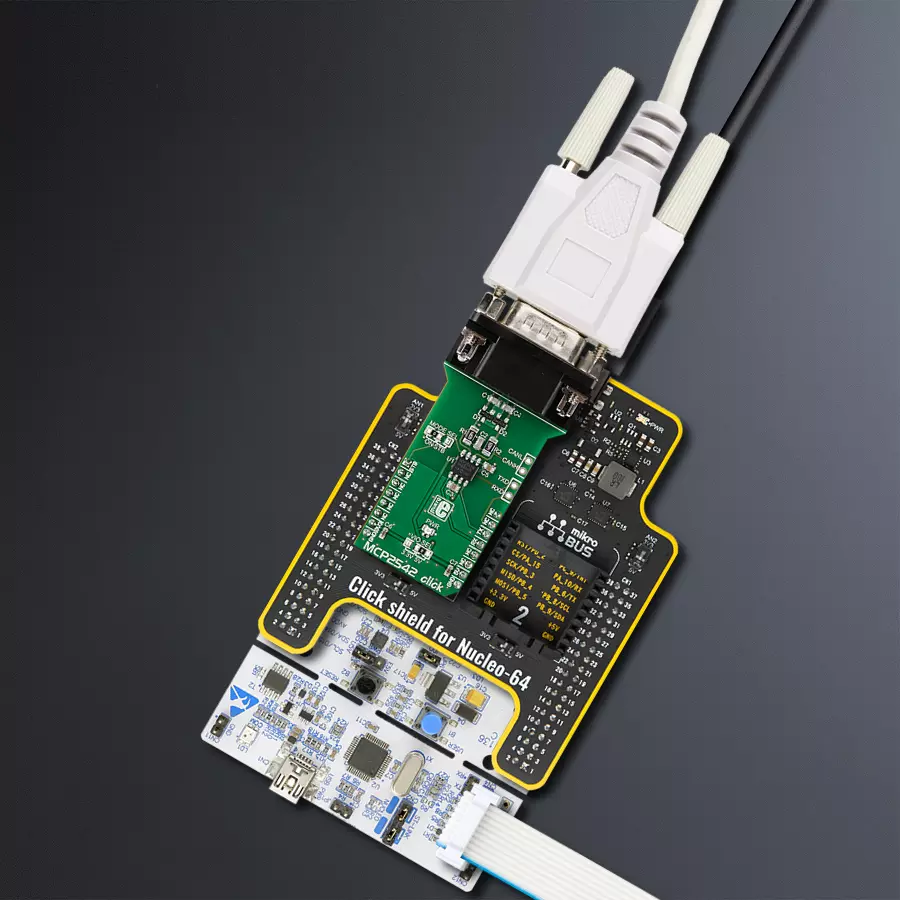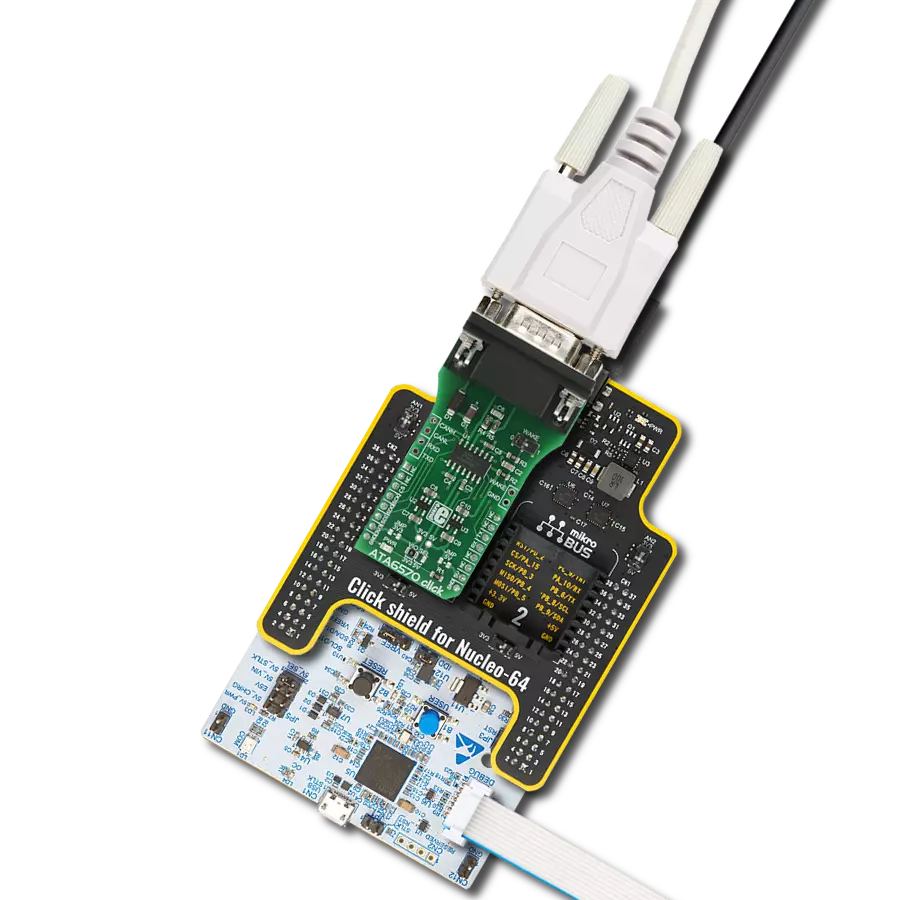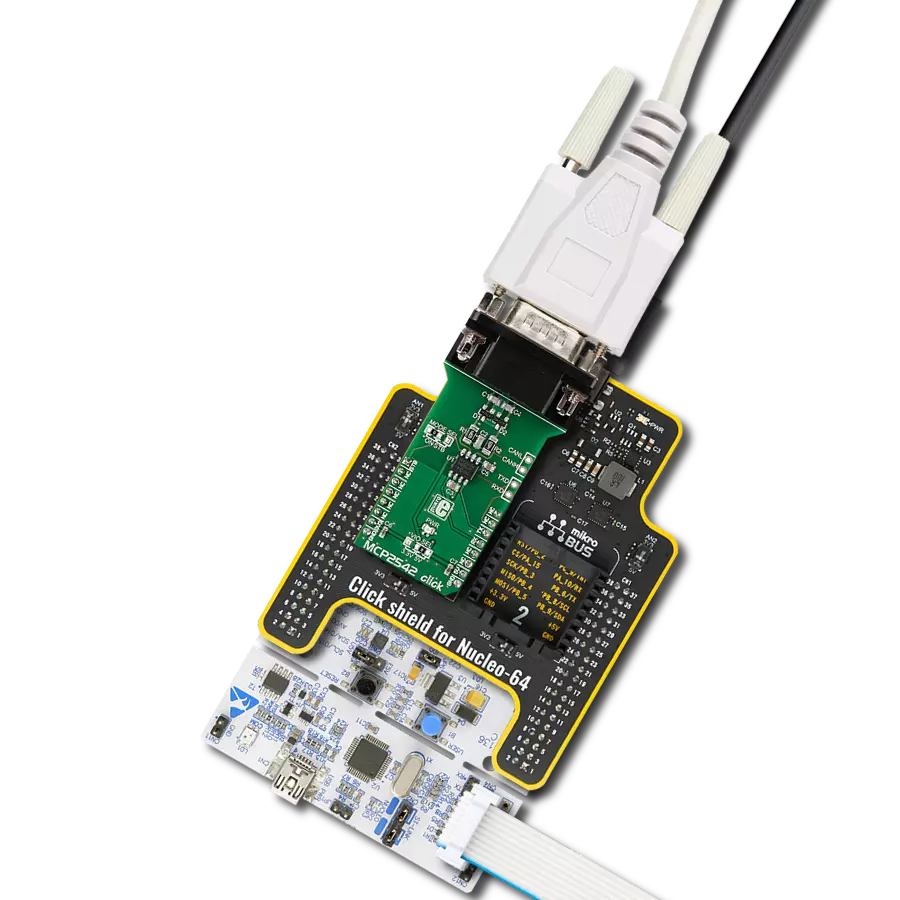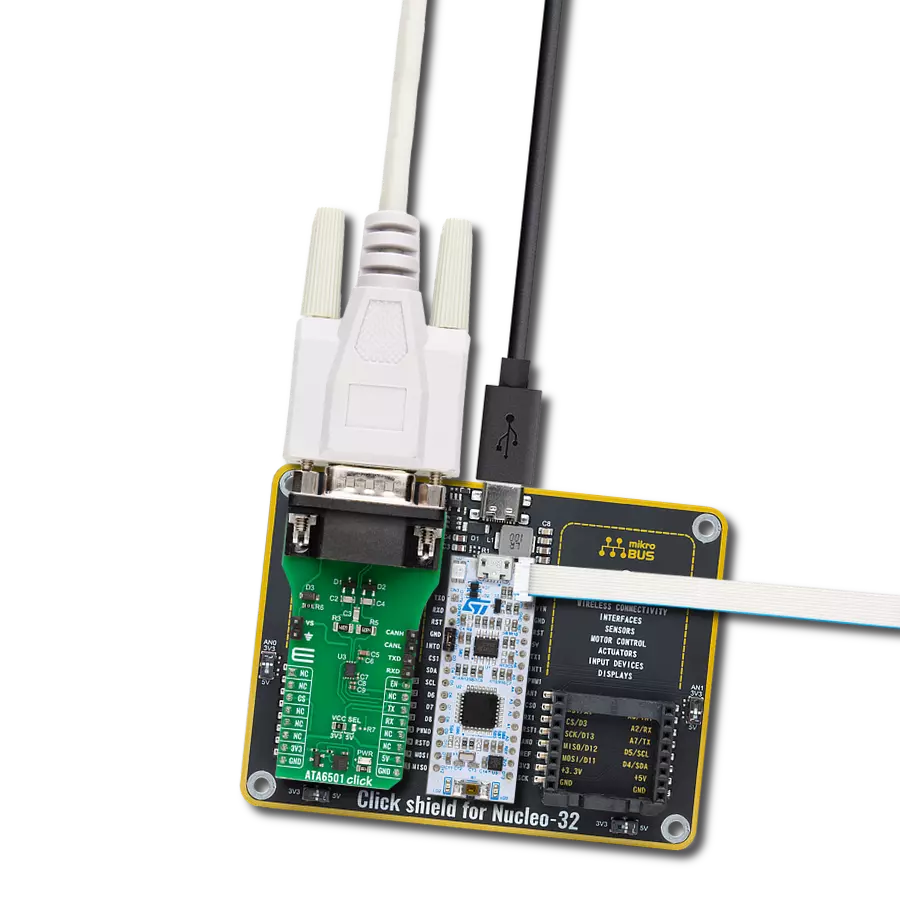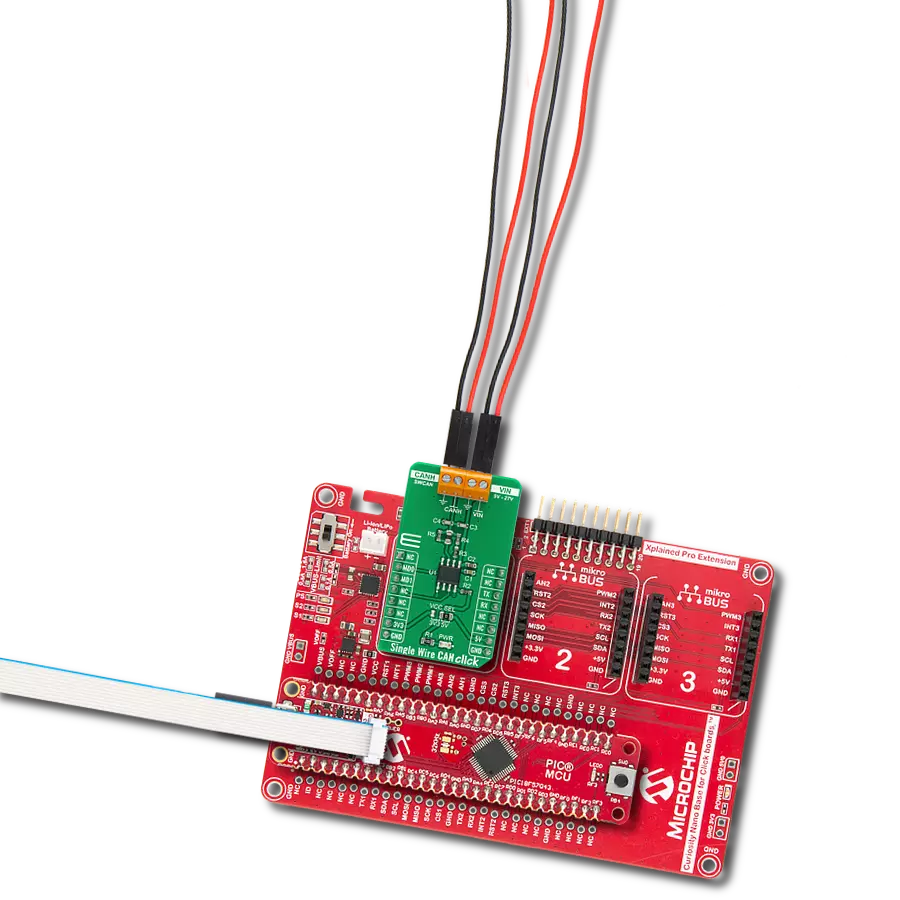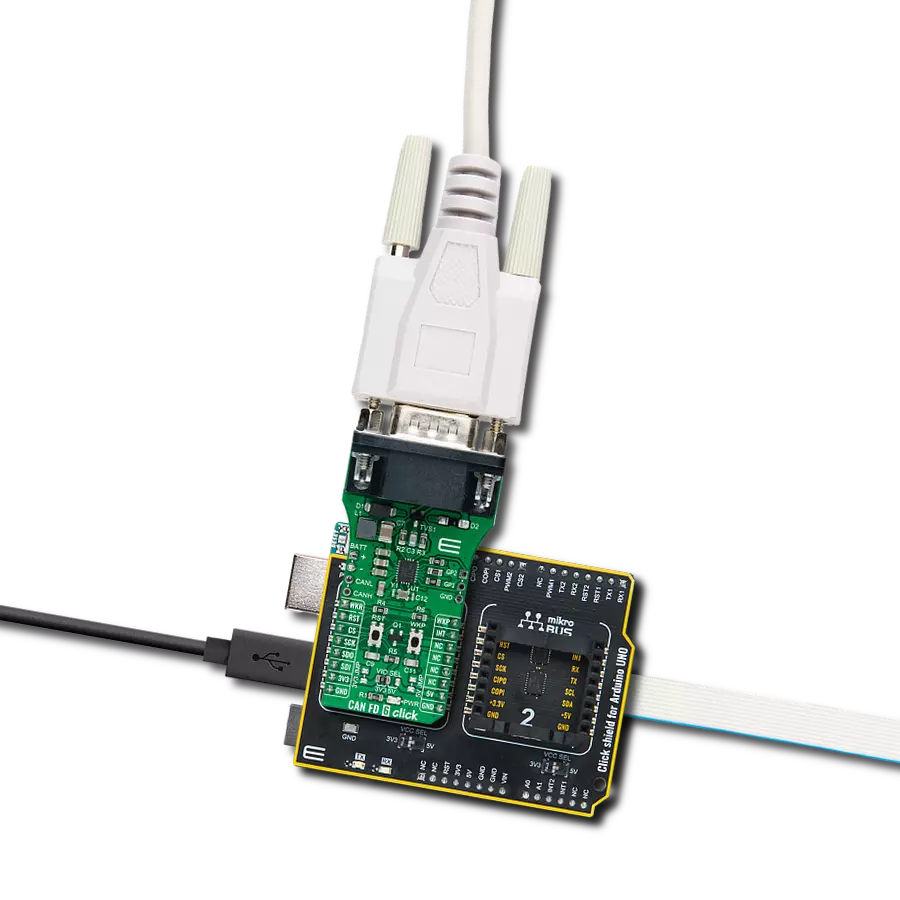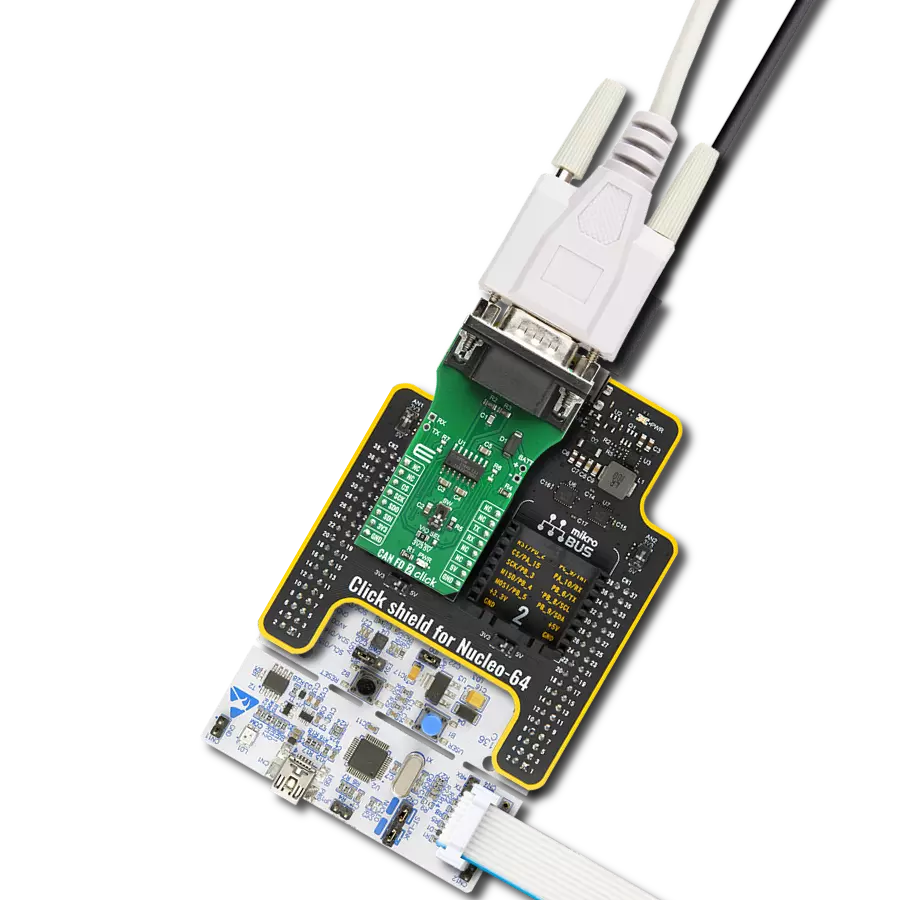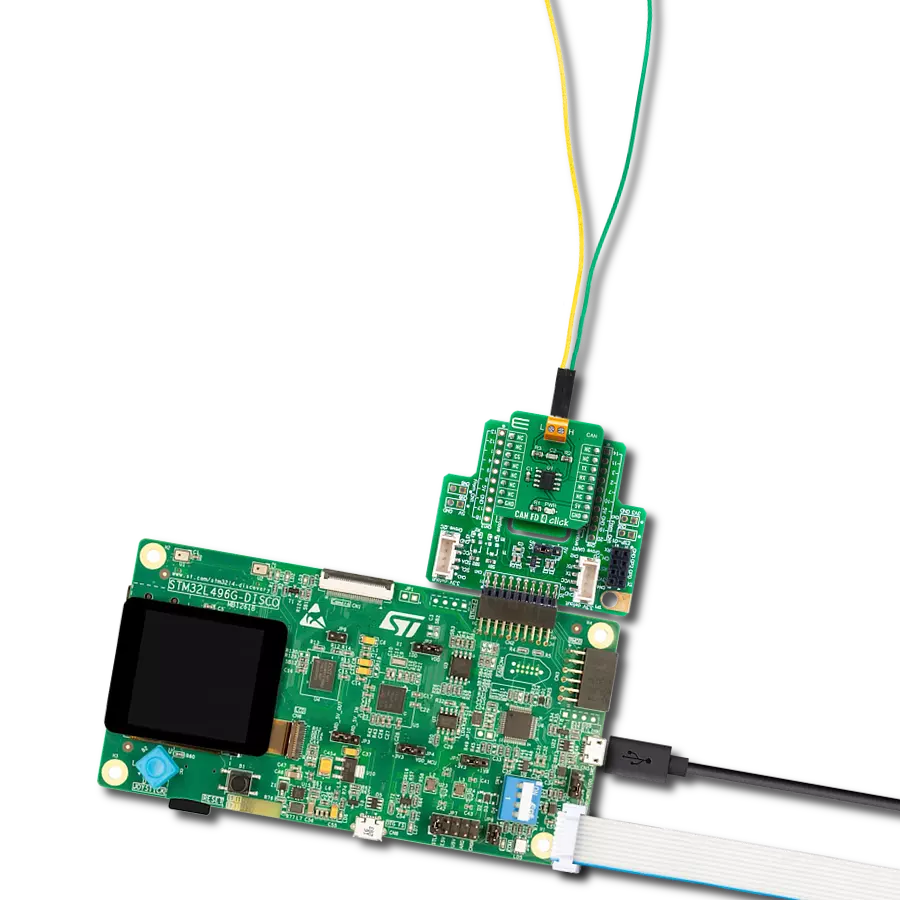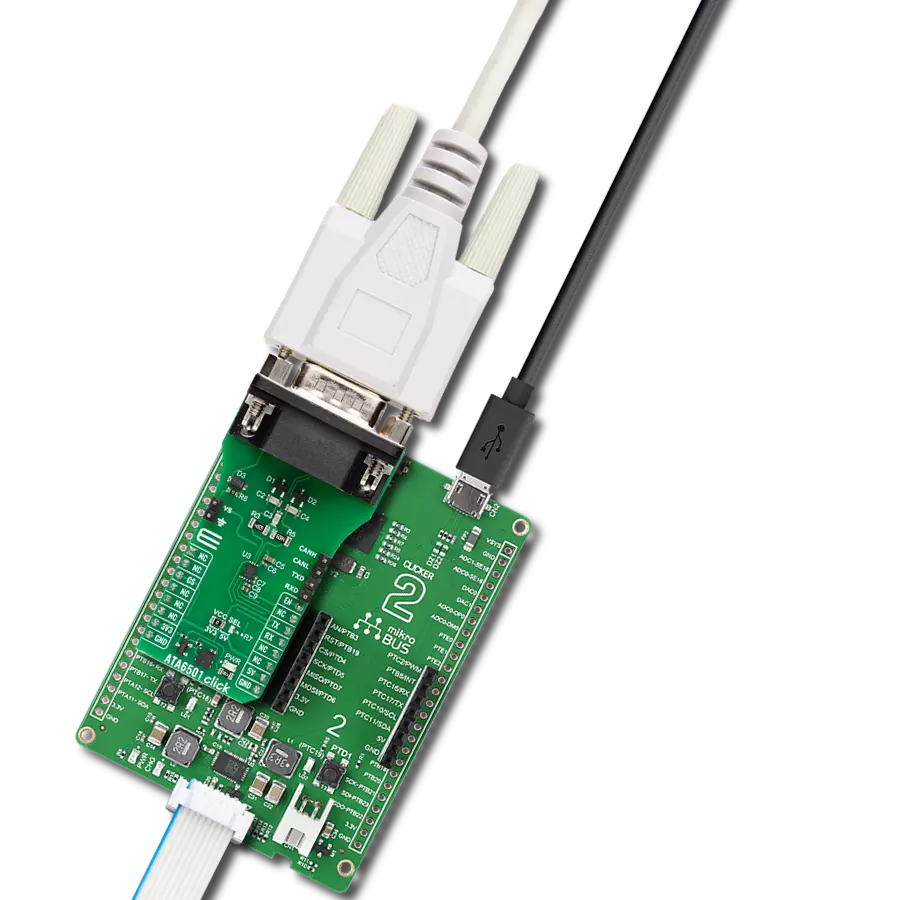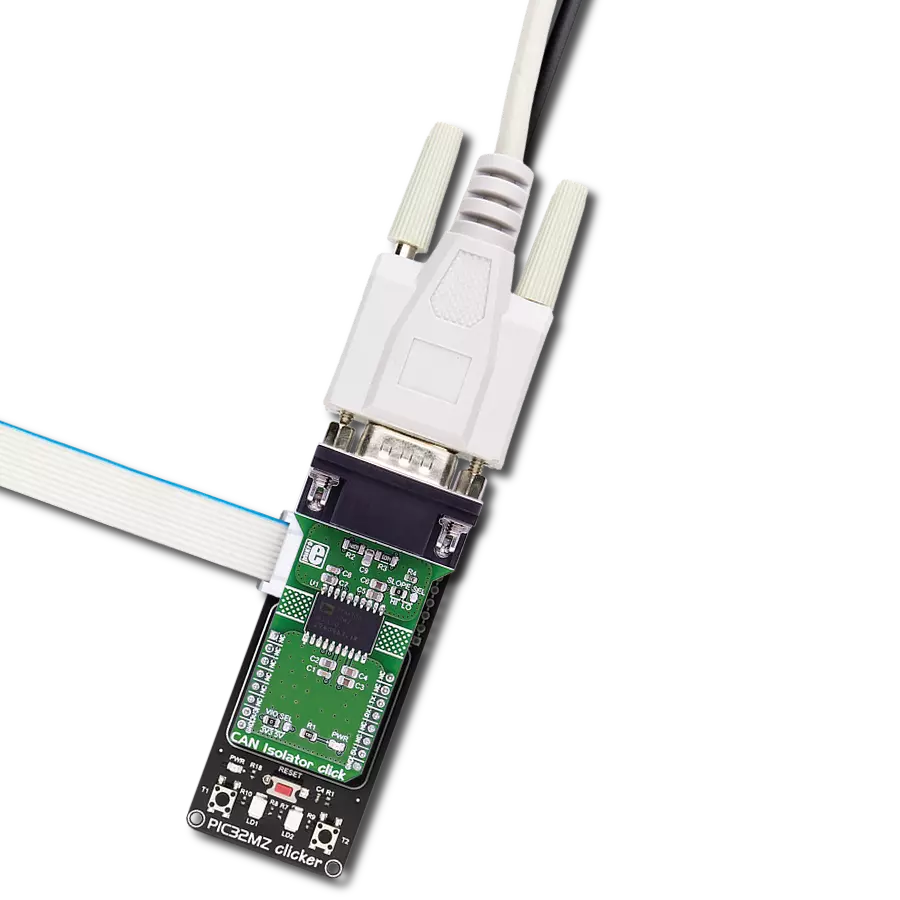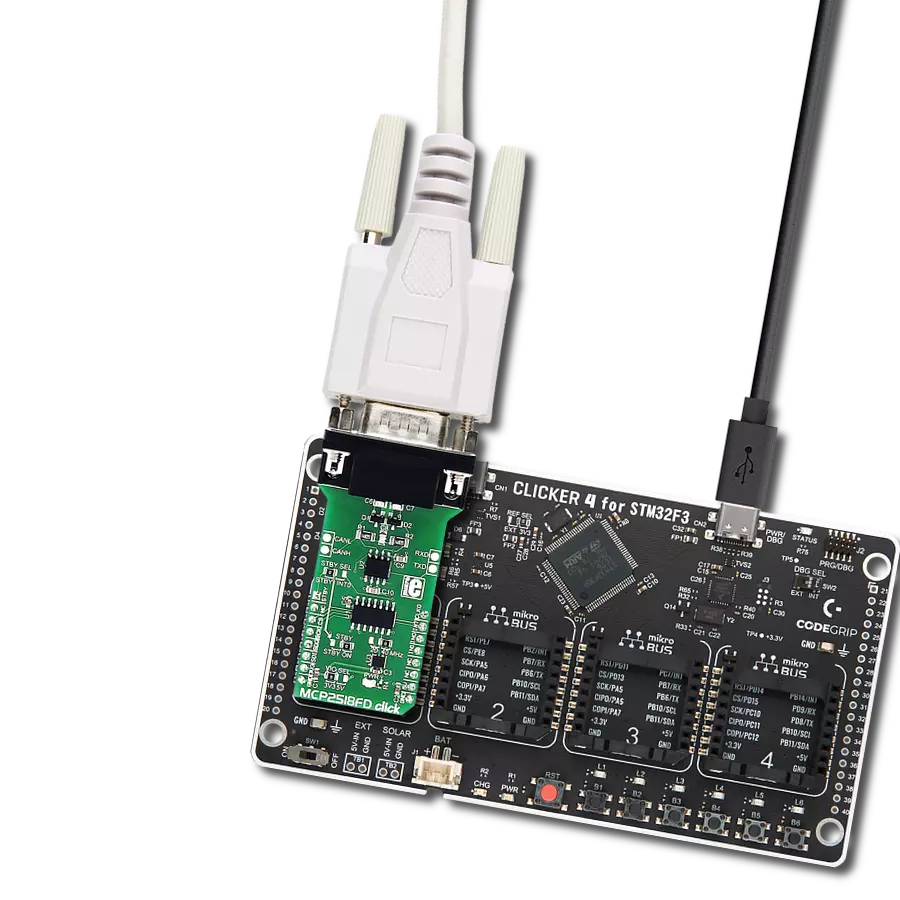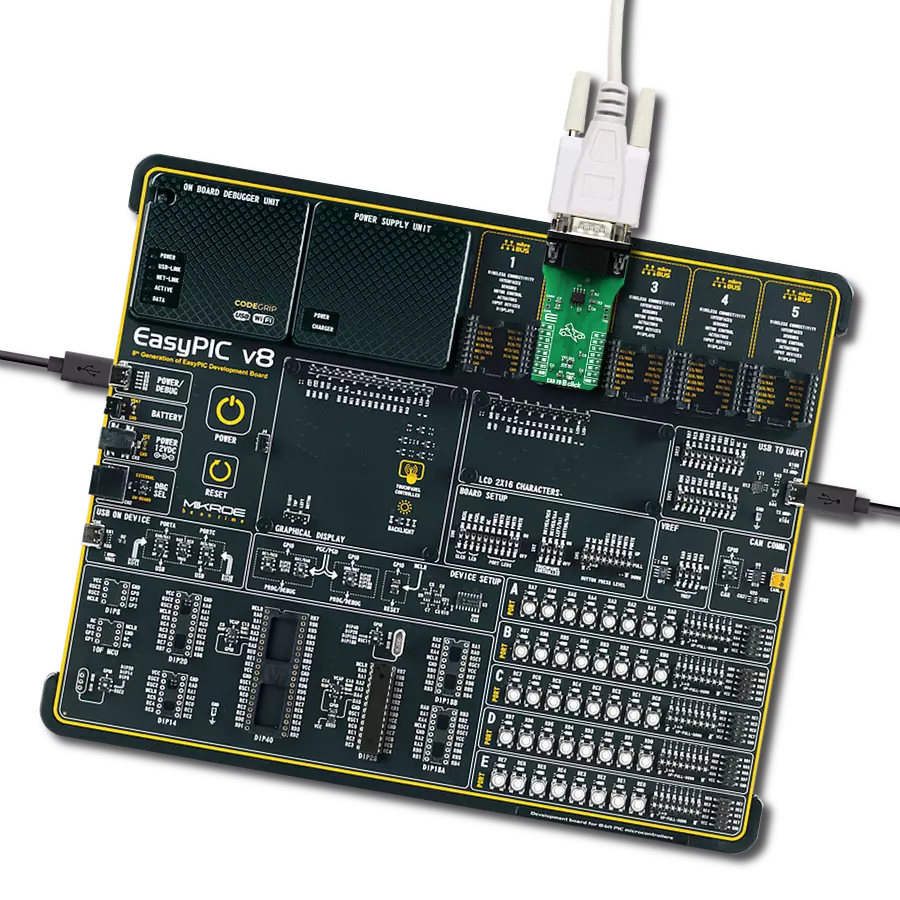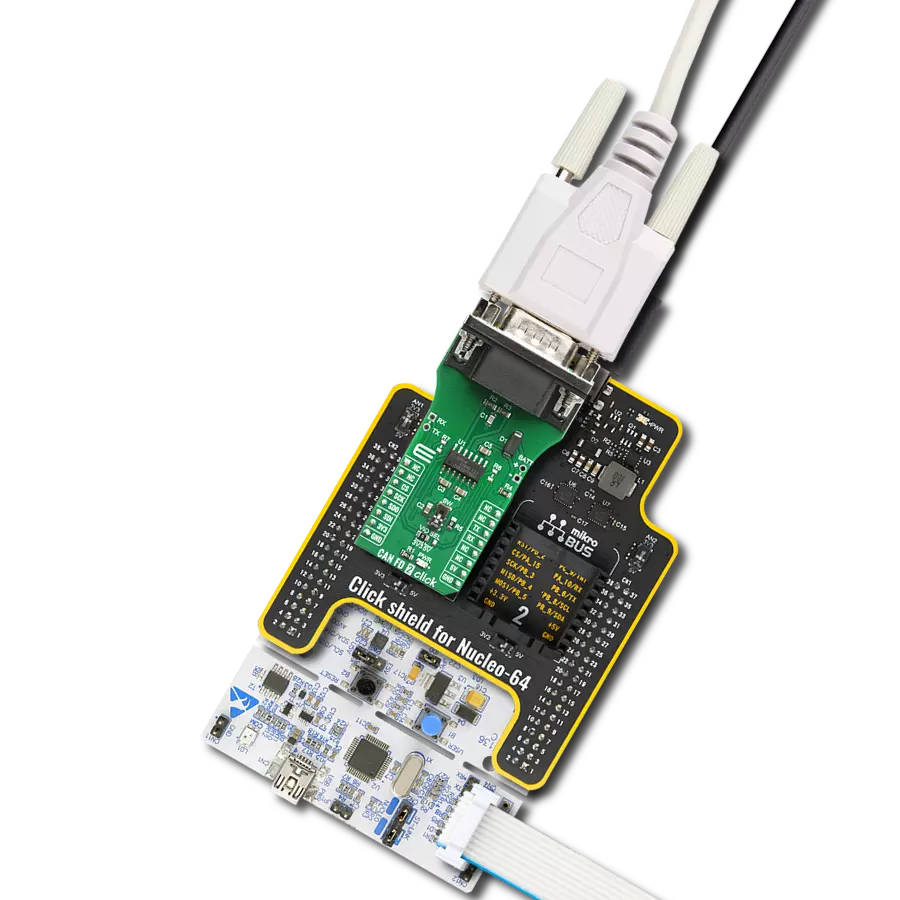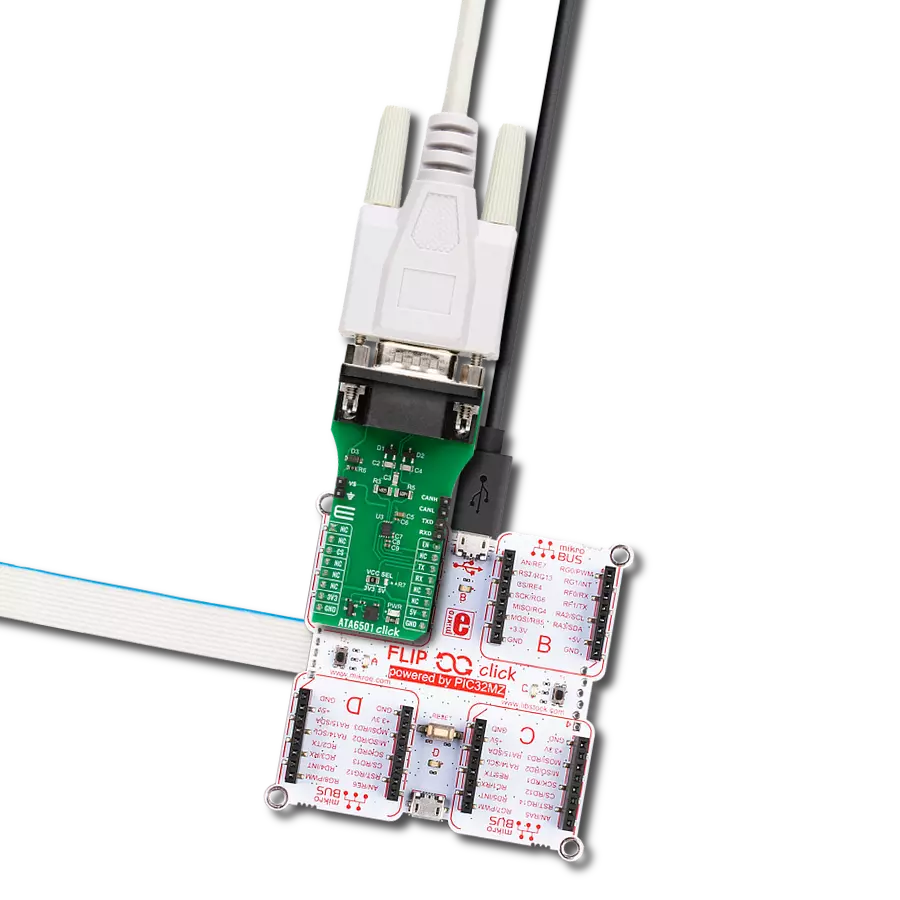Experience reliable and high-speed data communication with our advanced CAN transceiver, designed to facilitate seamless integration and robust performance within your network
A
A
Hardware Overview
How does it work?
MCP2542 Click is based on the MCP2542WFD, a CAN transceiver with a wake-up pattern from Microchip. This IC supports both CAN and recently established CAN FD protocols with up to 8Mbps. The communication through the CAN bus is differential and performed through the twisted pairs with the characteristic impedance of 120 Ω. The CANH and CANL drivers drive the differential lines integrated into the MCP2542WFD IC. This provides robustness and immunity to electromagnetic interferences, typically observed in automotive systems. The ISO 11898 standard defines a signal line of twisted-pair cable as the network topology, terminated by the resistors with the characteristic impedance of the CAN bus (120 Ω), at both ends of the bus - to prevent signal reflection. This Click board™ does not need a termination resistor and includes additional protection on the CAN bus. The CAN bus uses two states: dominant and recessive. The dominant state is when the differential voltage between the CANH and CANL bus lines is above the dominant state detection level (0.9V), while the recessive state is below the recessive state detection level
(0.5V). Allowed differential voltage on the CAN bus can range between -12V and 12V. The logic level on the TX pin controls CANH and CANL drivers. A HIGH logic level on the TX line results in the recessive state on the CAN bus, while a LOW logic level results in the dominant state on the CAN bus. TXD line has the internal pull-up resistor (HIGH), making the MCP2542WFD device stay in recessive mode if the pin is left floating. The dominant/recessive states on the CAN bus are used for the message priority arbitration: the node that transmits the signal with the higher priority (the lower the binary message identifier number, the higher the priority) will win the arbitration, and the node with the lower priority will abort the transmission, waiting for the bus to become available again. The CAN bus states are reflected on the RX pin: the dominant state will drive the RX pin to a LOW logic level, while the recessive state will drive it to a HIGH logic level. This pin is also connected to the power supply via the internal pull-up resistor. MCP2542 Click uses a standard 2-Wire UART interface to communicate with the host MCU with commonly used UART RX and TX
lines. These lines are also routed to the header on the side of the Click board™, allowing them to be used with some other device. Besides TX and RX lines, CANH and CANL bus lines are also routed to a header next to the RX and TX header. The MCP2542WFD supports a standby mode. This function can be selected over the MODE SEL jumper. If this jumper is set to the STB position, the STBY of the transceiver pin will be routed to the STB pin of the mikroBUS™ socket., allowing the MCU to control it. If the jumper is set to the ON position, it will be routed to the GND directly, not allowing the MCP2542WFD device to enter the Standby mode. Finally, a D-SUB 9 male connector on the Click board™ connects to a CAN bus directly. This Click board™ can operate with either 3.3V or 5V logic voltage levels selected via the VIO SEL jumper. This way, both 3.3V and 5V capable MCUs can use the communication lines properly. Also, this Click board™ comes equipped with a library containing easy-to-use functions and an example code that can be used as a reference for further development.
Features overview
Development board
Nucleo-64 with STM32F091RC MCU offers a cost-effective and adaptable platform for developers to explore new ideas and prototype their designs. This board harnesses the versatility of the STM32 microcontroller, enabling users to select the optimal balance of performance and power consumption for their projects. It accommodates the STM32 microcontroller in the LQFP64 package and includes essential components such as a user LED, which doubles as an ARDUINO® signal, alongside user and reset push-buttons, and a 32.768kHz crystal oscillator for precise timing operations. Designed with expansion and flexibility in mind, the Nucleo-64 board features an ARDUINO® Uno V3 expansion connector and ST morpho extension pin
headers, granting complete access to the STM32's I/Os for comprehensive project integration. Power supply options are adaptable, supporting ST-LINK USB VBUS or external power sources, ensuring adaptability in various development environments. The board also has an on-board ST-LINK debugger/programmer with USB re-enumeration capability, simplifying the programming and debugging process. Moreover, the board is designed to simplify advanced development with its external SMPS for efficient Vcore logic supply, support for USB Device full speed or USB SNK/UFP full speed, and built-in cryptographic features, enhancing both the power efficiency and security of projects. Additional connectivity is
provided through dedicated connectors for external SMPS experimentation, a USB connector for the ST-LINK, and a MIPI® debug connector, expanding the possibilities for hardware interfacing and experimentation. Developers will find extensive support through comprehensive free software libraries and examples, courtesy of the STM32Cube MCU Package. This, combined with compatibility with a wide array of Integrated Development Environments (IDEs), including IAR Embedded Workbench®, MDK-ARM, and STM32CubeIDE, ensures a smooth and efficient development experience, allowing users to fully leverage the capabilities of the Nucleo-64 board in their projects.
Microcontroller Overview
MCU Card / MCU
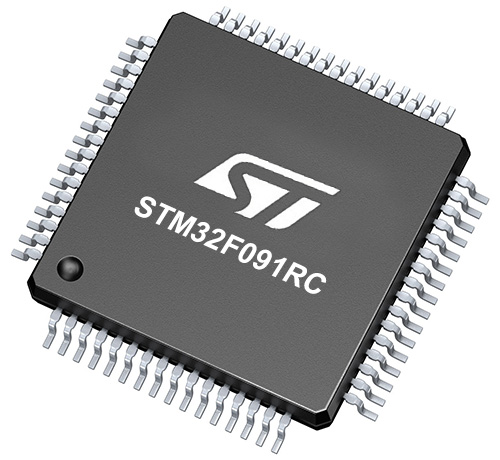
Architecture
ARM Cortex-M0
MCU Memory (KB)
256
Silicon Vendor
STMicroelectronics
Pin count
64
RAM (Bytes)
32768
You complete me!
Accessories
Click Shield for Nucleo-64 comes equipped with two proprietary mikroBUS™ sockets, allowing all the Click board™ devices to be interfaced with the STM32 Nucleo-64 board with no effort. This way, Mikroe allows its users to add any functionality from our ever-growing range of Click boards™, such as WiFi, GSM, GPS, Bluetooth, ZigBee, environmental sensors, LEDs, speech recognition, motor control, movement sensors, and many more. More than 1537 Click boards™, which can be stacked and integrated, are at your disposal. The STM32 Nucleo-64 boards are based on the microcontrollers in 64-pin packages, a 32-bit MCU with an ARM Cortex M4 processor operating at 84MHz, 512Kb Flash, and 96KB SRAM, divided into two regions where the top section represents the ST-Link/V2 debugger and programmer while the bottom section of the board is an actual development board. These boards are controlled and powered conveniently through a USB connection to program and efficiently debug the Nucleo-64 board out of the box, with an additional USB cable connected to the USB mini port on the board. Most of the STM32 microcontroller pins are brought to the IO pins on the left and right edge of the board, which are then connected to two existing mikroBUS™ sockets. This Click Shield also has several switches that perform functions such as selecting the logic levels of analog signals on mikroBUS™ sockets and selecting logic voltage levels of the mikroBUS™ sockets themselves. Besides, the user is offered the possibility of using any Click board™ with the help of existing bidirectional level-shifting voltage translators, regardless of whether the Click board™ operates at a 3.3V or 5V logic voltage level. Once you connect the STM32 Nucleo-64 board with our Click Shield for Nucleo-64, you can access hundreds of Click boards™, working with 3.3V or 5V logic voltage levels.
Used MCU Pins
mikroBUS™ mapper
Take a closer look
Click board™ Schematic

Step by step
Project assembly
Software Support
Library Description
This library contains API for MCP2542 Click driver.
Key functions:
mcp2542_generic_single_read- Generic single read functionmcp2542_generic_single_write- Generic single write functionmcp2542_generic_multi_write- Generic multi write function
Open Source
Code example
The complete application code and a ready-to-use project are available through the NECTO Studio Package Manager for direct installation in the NECTO Studio. The application code can also be found on the MIKROE GitHub account.
/*!
* \file
* \brief Mcp2542 Click example
*
* # Description
* This application use for comunication.
*
* The demo application is composed of two sections :
*
* ## Application Init
* Driver intialization.
*
* ## Application Task
* Checks if new data byte have received in rx buffer (ready for reading),
* and if ready than reads one byte from rx buffer. In second case aplication task writes
* message data via UART.
*
* \author MikroE Team
*
*/
// ------------------------------------------------------------------- INCLUDES
#include "board.h"
#include "log.h"
#include "mcp2542.h"
// ------------------------------------------------------------------ VARIABLES
#define DEMO_APP_RECEIVER
//#define DEMO_APP_TRANSMITER
static mcp2542_t mcp2542;
static log_t logger;
static uint8_t demo_message[ 9 ] = { 'M', 'i', 'k', 'r', 'o', 'E', 13, 10, 0 };
void application_init ( void )
{
log_cfg_t log_cfg;
mcp2542_cfg_t cfg;
/**
* Logger initialization.
* Default baud rate: 115200
* Default log level: LOG_LEVEL_DEBUG
* @note If USB_UART_RX and USB_UART_TX
* are defined as HAL_PIN_NC, you will
* need to define them manually for log to work.
* See @b LOG_MAP_USB_UART macro definition for detailed explanation.
*/
LOG_MAP_USB_UART( log_cfg );
log_init( &logger, &log_cfg );
log_info( &logger, "---- Application Init ----" );
// Click initialization.
mcp2542_cfg_setup( &cfg );
MCP2542_MAP_MIKROBUS( cfg, MIKROBUS_1 );
mcp2542_init( &mcp2542, &cfg );
mcp2542_default_cfg( &mcp2542 );
}
void application_task ( void )
{
uint8_t tmp;
// Task implementation.
#ifdef DEMO_APP_RECEIVER
// RECEIVER - UART polling
tmp = mcp2542_generic_single_read( &mcp2542 );
log_printf( &logger, "%c\r\n", tmp );
#endif
#ifdef DEMO_APP_TRANSMITER
// TRANSMITER - TX each 2 sec
mcp2542_generic_multi_write( &mcp2542, demo_message, 9 );
Delay_ms ( 1000 );
Delay_ms ( 1000 );
#endif
}
int main ( void )
{
/* Do not remove this line or clock might not be set correctly. */
#ifdef PREINIT_SUPPORTED
preinit();
#endif
application_init( );
for ( ; ; )
{
application_task( );
}
return 0;
}
// ------------------------------------------------------------------------ END
Additional Support
Resources
Category:CAN
